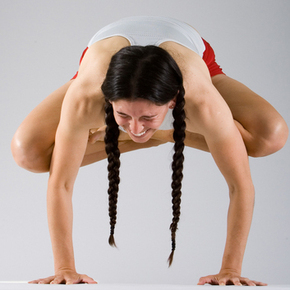Pelvic floor exercises are often overlooked, but in reality, they are essential for our health!
Many of us already go to the gym to lift weights or try different isolation machines. Those exercises help us build strong muscles. Unfortunately, it’s easy to forget about your pelvic floor because the muscles aren’t visible outside of your body. When you invest time in pelvic floor exercises, it can have a major positive effect on your body in the long-term.
To learn more about the health benefits of pelvic floor exercises, we reached out to 44 doctors, fitness, yoga and pilates experts and asked them one key question:
What are the benefits of adding pelvic floor exercises to your fitness routine?
We received an impressive variety of answers that you can read in the post below.
Hanna Assad – CEO of Gynie Inc.

It wasn’t until after my first labor that I understood the importance of pelvic floor exercises and a toned PC muscle. After my daughter’s birth, I had so much tearing that I needed 16 stitches. Because of this, I found myself being terrified to have another baby.
For me, adding pelvic floor exercises to my fitness routine allowed me to completely transform the birthing process. During my recent birth, the process was, beautiful, serene and almost pleasurable! I was so much stronger because I knew how to have full control over my pelvic floor strength.
In the beginning, I solely wanted to learn how to train the pelvic floor and PC muscle correctly to have an easier birthing process, but I found that many other benefits came! I started to experience benefits like a stronger core, better orgasms, and improved posture.
The trick is, to learn HOW to do Kegel exercises properly. There has been a lot of tabu about this topic, which I hope Gynie will be able to change for generations to come.
Gynie has completely transformed my entire life.
Dr. Trung Ngo – Novah Healthcare

The benefits of adding pelvic floor muscle exercises to your fitness routine are:
1) It improves core strength. The pelvic floor muscles are often forgotten as part of the core (in addition to the abdominal muscles, back muscles, and diaphragm). You need a strong and flexible pelvic floor to have a good core.
2) It decreases incontinence. Two pelvic floor muscles that are prone to injury in women during childbirth or strenuous activity are the pubococcygeus and puborectalis muscles. Any damage to these muscles can lead to incontinence, especially “stress incontinence” which is a very common issue in females.
3) It decreases pain and pressure in the vaginal area. One of the main causes of vaginal prolapse in young women these days is holding your breath and tightening the abdomen (effectively increasing the intra-abdominal pressure) while lifting heavy weights. It is always better to continue normal breathing during exercises but strengthening the pelvic floor muscles can help to reduce the risk of vaginal prolapse due to increased intra-abdominal pressure.
4) Performing regular pelvic floor muscles can improve bladder control and increase sexual function in both men and women.
Dr. Lev Kalika – New York Dynamic Neuromuscular Rehabilitation & Physical Therapy

Pelvic floor is a collection of muscles situated inside the pelvis and connecting urogenital organs, hips, pelvis, lumbar spine, abdominal cavity, core musculature and the diaphragm. By being an active participant within the pelvic and abdominal canister, pelvic floor participates in multiple bodily functions such as: micturition, defecation, sexual activities, birthing, spinal and lumbopelvic/hip control, and stability as well as breathing.
Since multiple complex anatomical connections coexist and cofunction together and are regulated by the same control centers in the Central Nervous System, any kind of problem in one area can affect another. Women with pelvic pain or incontinence are commonly troubled by: low back pain or hip and have abnormal breathing patterns.
Just like the diaphragm, pelvic floor muscles participate in the stabilization of the spine, hips, and pelvis while breathing and engagement in sexual activity or controlling bodies excretory function. For successful co-functioning of these systems, sensory awareness must be in place.
Unfortunately, due to the internal anatomical location of pelvic floor muscles, the visual representation of their function is not available to us. Therefore, we must rely on our proprioceptio[M1] n and interception. However, that is much difficult and many people from birth have a diminished ability to rely on these senses (motor blindness).
Another cause of creating isolated motor blindness in the pelvis is excessive sitting while another cause of isolated motor blindness is also stress. Naturally many people contract their pelvic floor muscles while being anxious. Yet another cause of this isolated motor blindness is using western toilets. Floor defecation (as it was used before toilet thrones were invented) provided daily training to the pelvic floor. In many Asian countries today, where old-style defecation is still used people have a lot less lower back pain. Scientists conclude that this is exactly for this reason.
Therefore, it would be beneficial to use pelvic floor exercises during gym routine. These exercises would not need to be strengthening the pelvic floor initially but rather integrate awareness type where the person acknowledges that he/she has these muscles and can equally relax them and contract them.
Muscle relaxation is a neurologically active process, and, in the beginning, special attention must be paid to that. The relaxation of the pelvic floor muscles is intimately connected to proper breathing and could lead to oxygen metabolism improvement. This is important for minimizing muscle fatigue and can lead to better performance.
On the other hand, people that can’t feel where their pelvic floor is can benefit initially from gentle isolated strengthening to increase awareness to the pelvis. Variety of insertable feedback tools can be used. Since pelvic floor exercises activate deep spinal stabilizers it tunes the body for better muscle efficiency by not allowing the over requirement of global stabilizers and therefore improves performance as well as prevents overuse injuries and low back pain.
Strengthening the pelvic floor can be just as important for women prone to or suffering from the use of incontinence products. However, I don’t recommend pelvic floor strengthening exercises unless it is particularly prescribed by your health professional who understands the state your pelvic floor muscles are in.
This can be established by examining pelvic floor muscles with diagnostic ultrasonography to establish modulus of function. Unfortunately, simple clinical examination does not provide similar results as rehabilitative diagnostic ultrasonography (aka RUSI).
One good word of advice for people who want using pelvic floor exercises during workouts is to focus on what state of contraction their pelvic floor in while they are lifting weights or performing other physical activities. This can be done by paying attention to your genital and anal sphincters. If you always keep them squeezed or squeeze them to move, then the weight you are using is too heavy or you are not yet ready for that athletic exercise.
Your pelvic floor’s state of relaxation can be a litmus paper to your exercise routine. The same can go for a number of reps if you start squeezing your pelvic floor later during maximizing your reps it can act as a sign to end the exercise if you cannot keep your pelvic floor relaxed.
Dr. David Greuner – NYC Surgical Associates

You’re most likely working out your legs, abs and arms at the gym, but are you regularly working to strengthen your pelvic floor muscles? Doing so is just as essential as maintaining the other parts of your body; pelvic floor exercises support and improve control of your bowel and bladder.
These exercises also reduce the risk of prolapse and increase sexual sensation.
Pelvic floor exercises are an important part of recovery for women post-childbirth and gynecological surgery, and for men post-prostate surgery.
Dr. Jill Stocker – The Body Well

There are so many components to sexual health, and by addressing all of these aspects it can literally take a person’s sex life to orgasmic proportions!
Optimizing a person’s hormones is KEY to so many aspects of their overall health and sexual health. If certain levels like testosterone(yes, women suffer from “Low T” too!) are low, there will not only be no actual drive to HAVE sex, but their ability to have a satisfying sexual interchange will be diminished as well.
It will be difficult for them to achieve an orgasm, and the quality of that orgasm will be muffled. Testosterone also affects a woman’s confidence level and feeling of sexiness, and can contribute to vaginal dryness…..so a true lack of “juiciness” all around.
There is definitely a hormonal recruitment component of exercise that boosts one’s own natural production of testosterone and growth hormone, and this is obtained with the HIIT training (High-Intensity Interval Training). HIIT training can be done in a gym, or in a class, or in the comfort of your own home.
The key is knowing your target heart rate that is needed to get to during the interval bursts so that it triggers your body to release those important hormones. This will not only yield a more physically fit physique that will help a woman feel sexier, but will help boost those important hormone levels, as well as neurotransmitter levels in the brain that help promote a more euphoric mood, also key to “getting in the mood”.
Another key component to a person’s sexual health is not just their sexual satisfaction and orgasm, but their sense of true intimacy and connection. This is something that is not necessarily an external thing or act, but rather a person’s connection to their inner self.
Meditation, mindfulness, and yoga (sometimes all wrapped up in one) is a direct portal to access this, and can help a person become more AWARE in every sense. Specific practices such as tantra focus on this awareness.
There are actual “exercises” that you can do with your partner to create more intimacy and a more fulfilling, connected sexual experience. These include eye gazing, “pillow play” intimacy games that create a heightened awareness of all of the senses, and touching each other in non-intimate areas so as to not focus on the endpoint of an orgasm, but rather riding the waves of intimate pleasure.
While I sometimes say jokingly “Saving lives, one orgasm at a time!”, it really is no joke, but an important part to a woman’s overall vitality!
Dr. Alex Tauberg – Tauberg Chiropractic

Unfortunately, the pelvic floor is one of the most neglected areas of the body. many people don’t do pelvic floor exercises. The pelvic floor, however, is a vital part of the core.
Adding these exercises to your regimen can help improve your core strength. Improving the core is great for many different reasons. It can lead to improved athletic performance as well as decrease the likelihood of injuries like back pain.
The pelvic floor can be used to increase the amount of abdominal pressure that you have. Increasing this abdominal pressure solidifies the core. It allows for our bodies to transmit greater amounts of force through that area.
Dr. Eugene Charles – Charles Seminars

Pelvic floor exercises are needed to strengthen the pelvic diaphragm muscles that are critically important for maintaining the integrity of the pelvic organs such as the uterus, bladder, and lower bowels.
Incontinence or urinary frequency, chronic constipation, infertility or impaired fecundity can be due to a misalignment of these organs as a result of a weakened pelvic diaphragm. Adding pelvic floor exercises stabilizes these organs and are an easy “cure” for embarrassing incontinence or in some people the heart-breaking failure to conceive or maintain a full pregnancy.
Additionally, pelvic floor exercises are an often overlooked aspect of maintaining low back stability and preventing sciatica pain.
Dr. Kelenne Tuitt – RMC Primary Care

Women tend to have looser ligaments than men which is desirable for childbirth but continuous laxity may contribute to uterine prolapse or bladder prolapse later in life. Pelvic floor exercises can be used to strengthen their muscles to maintain joint stability, reduce injuries, increase joint mobility and reduce uterine and bladder prolapse.
Estrogen is a hormone that can strengthen bones but it does not increase muscle mass or strength. Pelvic floor exercise in combination with estrogen can help to stabilize bones during the premenopausal years.
After menopause, with reduced estrogen production, weakness of the pelvic floor predisposes to urinary incontinence which can also cause pain with sex (dyspareunia). Therefore continuing pelvic floor exercises in postmenopausal women can help reduce urinary incontinence and painful intercourse
Dr. Rachel Gelman – Pelvic Health and Rehabilitation Center
While pelvic floor exercises can be beneficial, they can also have a negative impact if done incorrectly. Many people already have hypertonic (tight) pelvic floor muscles and doing pelvic floor exercises can lead to pelvic floor dysfunction which can cause bowel, bladder or sexual dysfunction and/or pelvic pain.
Before starting pelvic floor exercises a person should consult a pelvic floor specialist to determine if pelvic floor exercises are warranted and to ensure they are being done correctly.
Dr. Juanita Benedict

Some benefits from performing Kegel, or pelvic floor exercises include:
1. Reduced back pain (over 70% of women with chronic back pain have weak pelvic floor muscles)
2. Reduced or eliminated urine leakage with laughing, coughing, sneezing and exercising (it’s not normal although common)
3. And improved sex life (as the muscle coordination and strength can improve the feel and some say intensity of intercourse).
Keith Sparks – ICT Muscle & Joint Clinic
Benefits of Pelvic Floor exercises
The pelvic floor is the base of the “core.” Without a solid floor, there is no foundation which to hold stability. This will lead to increased injury rates and non-optimal function.
Think of the core as a piston; it drives up and down between the hips and shoulders. The pelvic floor gives resistance to the increased pressure created by the diaphragm dropping down into the belly. This increased pressure inside the core gives passive stability so the hip musculature can become prime movers instead of stabilizers of the core.
David Reavy – React Physical Therapy

From a musculoskeletal perspective, the body is an amazing reflexive and complex work of art. I want to simplify it to help it become more understandable for you so you can better achieve your fitness goals. I want you to work smarter, and provide you with better body awareness as the entire body works together. Meaning the proper contraction of your core muscles places your body (pelvis /spine) in a neutral position.
Let’s break it down into stabilizers and movers. If you are not stabilizing then this places more stress on your movers. This brings me to your pelvic floor.
A major stabilizer is your pelvic floor, which I consider part of your core. The pelvic floor attaches to the bottom of your pelvis while the commonly known abdominals connect the top of your pelvis to the thorax.
The proper contraction of your core places your pelvis in a neutral position. This minimizes musculoskeletal imbalances due to more efficient co-contractions and there minimizing injury and increasing force production because you are bringing more muscles to the party.
So you ask, how do you I do this!
Kegel! Yes, we all can kegel. When you kegel it will help your lower core muscles engage more, yes those “hard” to hit lower abdominals.
Here are a few exercises:
Inner thigh squats to activate 3 x 15
Supine ball squeezes – hold for endurance 3 for 1 min
Supine ball squeezes with bridging – hold for endurance 3 for 1 min
Supine ball squeezes knee to chest – slow down and up 4 secs up 7 secs down – 3x 10
Kegel with all abdominal exercises
Helene Byrne – BeFit-Mom

While having strong and flexible pelvic floor muscles are critically important in the childbearing years, the benefits reach far beyond pregnancy and childbirth.
The pelvic floor muscles (pubococcygeus group or PCs) are part of what in fitness is called the “inner unit” which includes the deepest abdominal muscle (the transverse abdominis), the diaphragm, and deep spinal muscles (the multifidus).
When working properly together as a synergistic unit, these 4 muscles:
- provide primary core stability for the torso
- smoothly relay tensile and compression forces throughout the spine during exercise and everyday movement
- prevent wear and tear injuries to weight-bearing joints (particularly at the sacroiliac joints, hip sockets, and lumbar spine)
- prevent ligament tears
- prevent muscle injuries
While the main focus in training the PCs has traditionally focused solely on isolating and strengthening the muscle during pregnancy, this perspective fails to account the vital role that the PCs play in overall good body mechanics and injury prevention.
Pregnant women need to build elasticity as much as strength in the PCs, as this is key to preventing tearing and/or the need for an episiotomy during labor.
Holly McDonald – Relief Physical Therapy

Pelvic floor muscles are part of our core. Keeping them strong provides support for all kinds of movement including pushing, pulling, reaching and lifting.
Pelvic floor muscles also control access for things to pass in, out and through our pelvis at the bottom; including urine, stool, gas, babies, and sex. Including pelvic floor exercise in your fitness routine will help maintain a healthy back and trunk, and help keep your private bodily functions in good working order.
Pelvic floor is a term used to identify a group of muscles that span the bottom of the pelvis. They support the structures inside and help us with control of bodily functions. While many of us do not ever really think about our pelvic floor, these muscles can be conditioned and kept healthy with regular exercise, just like any other part of our body.
The pelvic floor is a deep muscle group that when activated helps build stability and foundational structure. It is in the deepest layers of our “core.” Activation of the pelvic floor along with the multifidus in the spine, and the transverse abdominus is the cornerstone of deep core stability.
As we develop from childhood we develop strategies for using out pelvic floor muscles without really being aware that we use them. Sometimes the techniques we discover as children are not the most efficient ones. But our bodies are adaptable and can manage just fine… until something happens.
A car wreck, a fall from a ladder, a skiing injury, or childbirth can tip the scale to the point where our body can no longer manage with a substandard technique. Symptoms such as incontinence of urine or stool, or constipation, or pelvic pain can arise.
Regular activation of the pelvic floor muscles within a comprehensive exercise program helps maintain good muscle coordination. A healthy pelvic floor will help you have a strong core for maintaining an active life and keep embarrassing conditions at bay.
Fiona Gilbert

1. Long-term bladder control
As we age, bladder control can be an issue. Having a strong and flexible pelvic floor will support the bladder.
2. Deeper, more intense orgasms
A flexible and strong pelvic floor will allow both men and women to experience deeper, more intense orgasms as the muscles are able to have a larger range of motion in contraction.
3. Back and knee pain prevention
A strong pelvic floor will give stability to your back and hips. This will alleviate back and knee pain.
Jerry Snider – All In Health and Wellness

Pelvic Floor of Kegel exercises are an extremely important addition to your workout routine. As with all areas of your body with muscle the old adage is true, if you don’t use it you lose it. First off, muscle burns fat so if you have muscle and are not exercising it regularly then it’s not being as efficient in the fat burning process as you would like. A more specific benefit to your pelvic floor is bladder control.
Strong Kegel muscles provide support to your bladder, intestines and rectum. With better and stronger support you will experience fewer, or no, bladder leakage issues. Another benefit to working your Kegel muscles is enjoyment during intercourse.
When any muscle is strengthen from regular workouts, you have more conscious control over the use of the muscle. These muscles are part of your body’s core muscle group. These muscles work together to keep your posture and provide an optimum working space for your organs.
When any of these muscles are weak it will cause a domino effect that will cause problems in other areas. Meaning your back pain could actually be related to a weak pelvic floor. Your body has overcompensated for too long and stress your back to the point of chronic pain.
Too many people I see focus only on the muscles that you can visually see – your biceps, triceps, quadriceps, calves, etc. Do not forget the muscles you can’t see as they are often far more important to a properly working body.
Brent Reider – Yarlap

Perhaps the most talked about the reason for good pelvic floor muscles tone is that the muscles that spasmodically contract in orgasm include the pelvic floor muscles.
The ability to clench and relax with control is critical to sexual performance.
The pelvic floor muscles work with other muscles to hold our organs in their proper position and to manage the downward forces of our body weight.
Weakened pelvic floor muscles can cause the muscle in the lower back and thigh to work harder to manage the load.
If the pelvic floor muscles weaken, the organs shift from their natural putting pressure on the bladder. Causing loss of urinary control.
Pain-free and leak free movement improves sexual expression.
The great news about Kegels is that pelvic floor muscle tone can be regained at virtually any age.
Kaylyn Easton – Chiavare

All women, no matter what age, should incorporate pelvic floor exercises into their daily workout regime. Besides boosting sexual sensation and potential for orgasm, pelvic floor exercises can help you recover from pregnancy and childbirth, prevent prolapse, and increase bladder control.
Many pelvic floor specialists and gynecologists recommend our product to use in conjunction with pelvic floor exercises because it’s chemical-free and provides vaginal skin benefits.
Ashley Reid – Active Mom Fitness

The body’s “core” is a coordinated system of muscles that support the spine and pelvis, with the ceiling being the diaphragm and the bottom of the cylinder being the muscles of the pelvic floor. For the core to function properly as a unit, the pelvic floor muscles need to do their job.
Just as with other muscles, the pelvic floor muscles should have strength, endurance, coordination, and the ability to contract and relax; and just like with other muscles this happens with training and exercise.
Pelvic floor exercise can:
1. Improve the ability of your core to function as a unit, which means more core control and better movement quality during exercise…think injury prevention and progressing to more advanced fitness
2. Improve the quality of life for those dealing with incontinence or bowel dysfunction due to aging or pregnancy
3. Improve sexual intercourse…pelvic floor tightness can lead to painful sex, so sometimes training those muscles when to contract and relax is key.
Rock Hudson – Mavericks Fitness

The pelvic floor is what’s stopping you from wetting yourself. Sphincter control is also located in the pelvic floor. What other reason would you need?
All sensual and sexual health starts with the pelvic floor. Want to feel more relaxed and enjoy sex more? Work your pelvic floor.
Also, low back pain often comes from pelvic floor instability, especially where it is connected to the pubis and up to the recurs abdominus. It gets weak from sitting and our pelvis ends up in a poor position for hours. Over time the muscles around the pelvis, especially the psoas major, get tight, compressing the low back.
Caroline Topperman – Style On The Side

From a Pilates standpoint, strong, or well functioning pelvic floor muscles are necessary because they help stabilize the pelvis as well as support organs like the bladder and uterus which are located in the lower abdominal cavity. They work together with the deep abdominal and back muscles to give us a strong core, which is a focus of Pilates.
Extreme coughing, age, and childbirth are all factors in a weakened pelvic floor. Having to constantly worry about incontinence can be very debilitating in everyday life. In some more severe cases, a weak pelvic floor can cause one to experience a prolapse which is when your organs drop out of their natural positions.
You can think of the pelvic floor like an intricate web of muscles, ligaments, and tendons that support your pelvic bowl (yes it is literally shaped like a bowl). Not only that but a strong pelvic floor will benefit men after prostate surgery, it will help decrease any pelvic discomfort as well as possibly increasing sexual sensations and pleasure.
Pregnant women will generally be taught Kegels as a way to maintain a healthy pelvic floor but everyone can benefit from a variety of available exercises since they will only serve to make us stronger. In addition to Kegels, exercises like toe dips or hundreds in Pilates, are also designed to make us focus on increased strength and stability of our pelvic floor.
Carol Michaels Fitness

The pelvic floor muscles and ligaments support the bladder, bowel, and uterus. Therefore, these muscles must be strengthened regularly to prevent issues related to a weak pelvic floor. A weak pelvic floor increases the risk of incontinence and decreases bladder and bowel control.
Having a strong pelvic floor can reduce the risk of prolapse and can reduce pelvic pain during sex. It is especially important to add pelvic floor exercise to your routine especially after childbirth, menopause (getting older) or straining activities.
Laura Arndt – Matriarc

Working your pelvic floor is important for the following reasons. Your pelvic floor helps muscles act as a sling to help support your uterus, colon, and bladder. When your pelvic floor is weak this can lead to incontinence, pelvic organ prolapse, lower back pain, hip pain, and some other issues.
Being overweight, smoking, pregnancy and childbirth are some of the leading causes of a weak pelvic floor. Isolating your pelvic floor, especially after childbirth, is important to ensure a strong core and build the foundation for a strong body.
Some of my favorite exercises are pelvic tilts, bridges, dead bug crunch and bird dogs.
Nicole Brodie

I like to do core strength training – squats, alternate arm and leg raises, hip thrusters/bridges are my favorites which teach the body to engage the pelvic floor – less traditional than kegels.
Benefits of these exercises is a strengthened pelvic floor which can be weakened with age, after childbirth, pregnancy and weight gain. Weakening can cause poor bladder and bowel control. Many women may lose control when laughing and sneezing.
The benefits include an improved lifestyle as living with serious pelvic floor issues can have a serious and even traumatizing impact on ones day to day life. A bonus of core strengthening is keeping fit and healthy at the same time!
Rita Matraia – The Core Connection

Pelvic floor awareness and exercises are vitally important, because your pelvic floor is at the base of your core and should be involved in every exercise you perform.
There is a misconception that pelvic floor isolation exercises, such as Kegels, are the only way to strengthen the pelvic floor. While Kegels can play a role, the most lasting benefits come from incorporating pelvic floor support and awareness into everyday life.
Here’s a fun way to determine if your pelvic floor is engaging properly during exercise: While blowing up a balloon, determine if you bear down on your pelvic floor as you exhale. If you do, that breath and connection to your pelvic floor is off and you need to practice engaging up as you blow out.
People that bear down are at risk for incontinence. This prolapse can make things worse. So Kegels play a role in getting the firing pattern right, but once that is established it should be automatic.
Tara Langdale-Schmidt – Vuva Tech

Pelvic floor physical therapy can also be very helpful and is highly recommended for those millions of women who suffer from sexual/pelvic pain. Vulvodynia and other pelvic pain conditions can send your pelvic floor muscles into spasms which can be calmed by doing pelvic floor stretches.
Before your pelvic floor reaches the point of spasms, it is important to add pelvic floor stretchers into your daily routine to reduce them. Your pelvic muscles may always become weak which can lead to pain as well. Stretches can keep these muscles strong along with adequate blood flow to the area which in turn can reduce pain.
You can reduce bladder incontinence and pelvic floor prolapse symptoms with the correct stretching routine that a physician or pelvic floor physical therapist creates for you.
Karen Shopoff Rooff – Running On Balance

Many women believe that a leaky pelvic floor is just part of having babies or getting older. While it’s common, it is not normal! Your pelvic floor is designed to keep your urine, bladder, vagina, and uterus where they’re supposed to be.
Adding pelvic floor exercises allows women to be confident that they can laugh, sneeze, jump, or run without leaking. Regular pelvic floor exercises also help to prevent prolapse.
Because the quality of life is so negatively affected when women have a prolapse, pelvic floors are a free, easy, and available way to keep your body in it’s the best shape. And starting pelvic floor exercises early in life means women are better able to maintain pelvic health as they move through menopause.
Amy Jordan – WundaBar

A healthy pelvic floor is crucial to proper breathing and core strength – surprise; it’s not just about a six pack! An easy way to improve pelvic floor conditioning is by simply placing a 5″ ball halfway between the knees and hips for squats. The inner thigh muscle fibers and fascia are connected to the pelvic floor and waistline – this tip will also help to build stability for your knees in any activity! Make sure you hold the ball as if you’ll almost drop it rather than squeezing it.
Another thing you can try is this – the next time you sit down to pee, allow the urine to flow for 2 – 3 seconds then s-l-o-w-l-y stop the flow of urine entirely. Think of it more like elevator doors gliding closed rather than slamming shut. Then slowly release the muscles to allow yourself to finish using the restroom. Do this only ONCE when you use the restroom, and it will help to condition your pelvic floor so you can cough and laugh again without worrying about anything leaking!
Nicholas Rizzo – Run Repeat

Thought I would make this simpler and just list out the benefits outside of the sex-related benefits:
1) It isn’t commonly known but the pelvic floor is actually a part of “your core” muscles. It actually is connected with your lower abs and lower back. So having a strong pelvic floor is important for overall core health, strength, and so on.
2) Pre & Post Pregnancy – A strong pelvic floor before pregnancy will really help with additional support of the extra added weight that is gained. Again, as it is connected to the lower abs and lower back, having strong pelvic floor will provide support to these muscle groups and also reduce the resulting aches and pains.
After your pregnancy, it is important to work on this as well to help improve the recovery process.
3) As with any training, building pelvic floor strength means increased blood flow, recovery of muscle, increases in blood vessels, and so on. Helping aid a healthy and highly functioning environment which is just great for overall health.
4) There is a lot of detail that could be given about incontinence but I will keep it simple and say that it will help reduce the chances of leaks. In fact, weightlifting, in general, helps this because it also helps build your pelvic floor (as well as all other) muscles.
Stephanie Larson – Dancing For Birth

Pelvic floor exercises are especially important during pregnancy and postpartum. However, most people do them incorrectly. Pregnant women are often told they should do hundreds daily in order to prepare for birth, but this is not necessary. A tight pelvic floor shouldn’t be the goal―a toned yet supple pelvic floor is key.
Think of the pelvic floor like a hammock suspended between two trees. Pelvic floor contracting exercises (such as ‘kegels’) tone the front. The most effective way to tone the back of the pelvic floor is to dance. When you bend your knees and move your hips it activates the glutes and helps to create a toned yet supple pelvic floor.
Properly exercising your pelvic floor can help with birth and recovery, sexual satisfaction and the prevention of incontinence and organ prolapse.
GinaJi Caccavalla – Ayur Yoga Tantra Spa

Numerous Benefits include, forever life-changing improvements to your Mind, Body, Spirit, and Sex!
From a western fitness perspective, your whole-body benefits from Pelvic Floor Exercises, inside and out, because it’s your physical foundation. It affects how you stand and move in the world physically.
From an eastern, holistic or mind-body fitness perspective the benefits are multi-dimensional, including, Mental, Physical, Emotional, Energetic, even Sexual and Spiritual Wellness, if you want to take it there?
The Pelvic Floor is part of the core, which includes the muscles of your back abdomen and pelvic region, actually the floor of the core. A strong and flexible Pelvic Floor supports great back and core strength. This enhances all physical activity and improves your posture.
Male and Female sex organs, sex glands and reflex points in and around the pelvic cavity receive stimulated blood, energy and oxygen flow. This is also toning and rejuvenating for digestive and reproductive organs and organ systems balance, improving their functions, hormonal balance and libido for men and women.
Female benefits include urinary bladder control with prevention, reduction, and reversal of urinary bladder issues like weakness, incontinence, frequent urination, and nocturia.
Male Benefits include urinary bladder and bowel control, along with prostate health. Reduces and eliminates, frequent urination, dribbling, pain during or after ejaculation, erectile dysfunction and premature ejaculation. Resulting in organ toning and prostate gland rejuvenation, improving sexual performance.
These benefits and more like, sexual vitality and spiritual energy have been long appreciated because these exercises have been practiced and prescribed for thousands of years by the ancients. Chinese, Taoist, Japanese and Ayurvedic Medicine a sister science to Yoga use terms like “The Root Chakra” Prana, Apana, Bandhas, Chi and Jing all associated with the pelvic floor for generating high performance and healing life forces, to support abundant health happiness and prosperity in all areas of your life!
A major benefit is the boost to mental, emotional confidence and expanding self-empowerment, simply by managing your own health through life experience, while restoring balance body and soul…This is transformation and benefit at its best!
SUCCESS TIP:
To fully receive, these life-changing benefits from your PF Exercises in any fitness routine, practice daily and breathe well! Pretend you have nostrils in and around your lower back, lower abdomen, and pelvic floor. Gradually focus your breath down there. Synchronize your breath with the rhythm of your practice without force or strain. Flow the breath to lower, middle and upper body and back down again. There are many breathing techniques and a variety of pelvic floor exercises. Experiment to find the one
that works best for you
Conni Ponturo – Absolute Pilates Upstairs

The importance of pelvic floor exercises is great for both men and women. First of all, inconsistence in women is filled with shame. So much so, women will wait eight or more years before ever saying anything.
The pelvic floor is the bottom sling of muscles that make of the lower abdominals. Adding the connection to the pelvic floor can deepen the feeling and strength of the abdominals.
It can give deeper satisfaction sexually in both men and women. The baseline for pelvic floor exercises is 250 kegel (pelvic floor) exercises a day. That can be an overwhelming number, so then people say I can’t do that and give up.
If we can break it down to 35, in the morning, 35, at lunch and then 35 at bedtime. It becomes much more doable and 100 have been accomplished. Serious pelvic floor dysfunction must be dealt with by a professional, but everyone can add daily exercises and see a big change. It is not just for women pre and postpartum. These exercises are for everyone.
Lyndsay Hirst – Your Pilates Physio

I think that because the pelvic floor muscle is hidden, it often gets neglected and forgotten about. Dysfunctions in the muscle don’t just happen to women that have had children. There are lots of benefits to including pelvic floor exercises. One of the obvious benefits to pelvic floor training is to treat incontinence.
Sometimes women find they are generally OK until they start to perform impact exercises such as jumping. They might find themselves leaking as they perform the activity. Think of the pelvic floor as having two types of muscle fibres; slow twitch and fast twitch. Slow twitch fibres will activate to hold your bladder and bowel until you can get to a toilet, whereas fast twitch fibres should kick in when you cough or sneeze or when you perform impact type activities such as jumping. I always suggest training the two fibres differently.
Building strength in the pelvic floor can prevent prolapses and can also be used to treat a prolapse.
The other major benefit of building pelvic floor strength is to reduce/prevent pelvic and back pain.
Lisa Alemi – Move Mama Move

Results of pelvic floor training exercises added to fitness program
1. The pelvic floor muscles help support the abdominal and back muscles that stabilize the spine. Therefore, you can gain a number of additional benefits from strengthening pelvic floor muscles. Your posture is improved because you can hold yourself in a more upright position. This will lead to improved comfort in the neck, mid-back, and spine.
You are also less prone to back and hip pain with a strengthened pelvic floor. When the muscles of the pelvic floor are strong, there is less stress on the superficial back and abdominal muscles which typically cause back and hip pain when they are overworked.
2. Pelvic floor training can also improve bladder and bowel control and positioning. The muscles of the pelvic floor assist in positioning the pelvic organs like the bladder, uterus, and bowel. When pelvic floor muscles are weak, you may experience the need to use the restroom frequently, or even bowel or bladder leakage.
Strengthening the pelvic floor improves control bowel and bladder during episodes of coughing, laughing, and sneezing. Prolapse of the bowel, bladder, or uterus can also occur with a weakened pelvic floor. Strengthening the pelvic floor will improve the position of the pelvic organs, preventing prolapse.
3. Strengthening the pelvic floor can also improve sexual sensation for both men and women. Nerves related to sensation in the genital area may be enhanced with a strong pelvic floor compared to a weak pelvic floor.
Ife – The Fit In: Bedford Stuyvesant

The Pelvic Floor is part of a strong core. It’s the hammock keeping your internal organs from dropping out the bottom.
A weak pelvic floor can cause incontinence (difficulty controlling urination) but can also cause your organs to herniate into other areas like your uterus dropping.
Tightening of the pelvic floor muscles is important in keeping everything where it is supposed to be, especially during moments of increased abdominal and pelvic pressure like lifting weights. But just as important as it is to tighten, it’s also important to learn how to relax the muscles for normal activities like sex and vaginal births.
Lauren Seib

Have you ever heard, “Draw your pelvic floor in and up” or “mule bandha” in barre/yoga class? For women, this means contracting the muscles at the bottom of the pelvic floor, behind the cervix. (For men, the area between the anus and testes…) It’s strange to think about at first, however, once you start “using” this deep core lock, the way you move is going to feel and look a lot different–oh, and so will your abs!
To start, your pelvic floor is a series of hammock-like muscles, ligaments and connective tissues that hold pelvic organs in place. When weakened, the pelvic organs can sag or collapse, known as pelvic organ prolapse (leading to incontinence, pain, discomfort, etc.) Strengthening these muscles not only prevent these conditions but as a key component of the inner core, they support strength/stability for your hips and spine.
I start my clients supine, especially post-pregnancy, honing in on kegel-like engagement while on the floor before progressing to plank, glute bridges, squats and challenging abdominal exercises.
Alysa Boan – Fitness Trainer

Pelvic floor exercises are highly encouraged by doctors and trainers alike, not only because they improve sex life by increasing the chance of orgasms, but they are also a major piece of postpartum recovery.
Strengthening your pelvic floor muscles can help with digestion, incontinence post-pregnancy, and tightening of muscles surrounding your sex organs – win-win ladies!
So if you are just looking for a better sex life or see a pregnancy in your future, add pelvic floor exercises to your daily fitness routine to ensure the muscles are strong and firing properly.
Crystal Widmann – Y2B Fit

A few reasons why it’s super important to do pelvic floor exercises:
1. For women, doing pelvic floor exercises prepares them for the labor + delivery process since the pelvic floor helps to push the baby out.
2. Pelvic floor exercises (before pregnancy) help to improve tone and mean a quicker recovery after pregnancy.
3. Pelvic floor exercises can improve a woman’s orgasm!
4. The pelvic floor and transverse abs (deep core muscle) are closely related. If you’re working the ab muscles without engaging the pelvic floor, you could actually weaken the pelvic floor by causing downward pressure on it. For this reason, it’s very important to work the pelvic floor and core at the same time!
Rachel Scott

The pelvic floor is a key muscle in core stabilization. Through mindful engagement of the pelvic floor, the practitioner improves core stability, prompts a concurrent engagement of transverse abdominis (the deepest abdominal layer), and generates a steady foundation through which the more superficial muscles may effectively work.
In yoga, we recruit the pelvic floor through engaging mula bandha, which is a gentle drawing up of the pelvic floor. However, the pelvic floor does not work in isolation; it is part of a myo-fascial meridian called the Deep Front Line, which runs from the soles of your feet all the way to the skull
Although it can be useful to practice pelvic floor isolations, begin to tune into the connection that your pelvic floor may have with other areas of your body. For example, engaging the adductors (inner thighs) can spontaneously prompt an engagement of the pelvic floor.]
Also, when doing pelvic floor exercises, it is also important to remember that the pelvic floor must be able to relax as much as it is able to engage. Make sure to soften as well as activate.
Hannah Faulkner – Half Moon Yoga And Art

Yoga postures combined with conscious breathing create strength, stability, softness, and flexibility for pelvic floor health. Having balanced muscles in this region between the pubic bone, tailbone, and sit bones acts like a scaffold to hold our lower internal organs in place. When we are too tight, loose, or simply unbalanced from right to left we could have spinal problems, sciatic pain, bladder weakness, digestive and menstrual difficulties or even reduced sexual sensation and orgasmic potential!
As many yogis know, breathing deeply is essential to overall well-being. Did you know that the pelvic floor actually works together with your diaphragm? When we inhale, the diaphragm pushes the abdominal organs down while stretching the pelvic floor muscles. As we exhale, the diaphragm contracts and the organs lift.
Practicing a wide range of yoga poses with mindful breathing is the key to keeping the entire body healthy and balanced. Mountain Pose with a block in between the thighs aids in strengthening the pelvic floor. In Chair Pose, the action of sitting back stretches the pelvic floor, while rising back up lifts it. Happy Baby, Squat, and Goddess postures expand these muscles with a natural contraction and subtle lift on the exhale.
Warrior 3 and Standing Splits are excellent for stretching. Tree, Warrior 2, and Bound Angle open this region. And Locust are Bridge are important for softening, creating a counter-balance as they strengthen the glutes.
Pamela Crane – Crane Yoga Therapy

Imbalances in the pelvic floor can happen when the pelvic floor muscles are too tight, too weak, or too long.
· Exercises to strengthen, tighten, or release the pelvic floor are beneficial in helping to relieve constipation, back pain, hip pain, incontinence, and more.
· The key is finding the imbalance and then adjusting the exercises accordingly.
· Many people are holding tension in their pelvic floor causing trouble with urination and defecation, so exercises to release would be more important for them than exercises to strengthen.
· A weak pelvic floor can be responsible for many conditions including back pain, so strengthening the floor would be the first step in alleviating non-specific back pain.
Shana Meyerson – YOGAthletica.com

When people exercise, they tend to be primarily concerned with how they look on the outside, totally neglecting the most important aspect of health and longevity: being healthy on the inside.
In yoga, the pelvic floor is considered to be an extremely important muscle group that deserves significant attention. You will often hear references to “mula bandha”, an elusive concept to many that, at its most basic level, means engaging, strengthening and lifting the pelvic floor. Why is this so important?
On a purely medical basis, a strong pelvic floor helps to reduce your chances of prolapse, the slipping, falling, and collapsing of the internal organs. Especially when combined with a regular inversion practice, strengthening the pelvic floor helps to keep your internal organs in place and functioning at optimal capacity.
Beyond that, one of the most common symptoms of a weak pelvic floor (especially as we age) is urinary and/or fecal incontinence. Unpleasant and inconvenient, such incontinence can usually be avoided or alleviated by regular and proper pelvic floor exercise. And, male or female, pelvic strength will also help you to recover from reproductive traumas, such as prostate surgery or childbirth.
Melanie Kotcher

The benefits of adding pelvic floor exercises to your routine are:
- They give you more control over your bladder and bowel function
- They can strengthen and tighten your core
- They can relieve back pain due to a stronger core and spine
- They can reduce the risk of prolapse (slipping down of internal organs)
- They can aid in better recovery from childbirth and surgery (in women).
Robert Herbst – W8lifterusa.com

Doing pelvic floor exercises can bring a number of benefits. First, they will help to provide greater bladder control to prevent incontinence. Many women, especially as they get older or after childbirth, develop some incontinence where they release some urine under stresses such as laughing or weightlifting. I knew a woman who would urinate every time she deadlifted. This, of course, made exercising at a gym embarrassing. Pelvic exercises will strengthen the associated muscles to give more control. The exercises will also complement exercises she is doing for her core to give her better overall strength and posture.
The exercises will also give the woman greater awareness and control over her vaginal muscles. This would enable her to actively use them during intercourse to improve her and her partner’s sensation. The strength and control may also enable her too better enjoy A vigorous sexual activity without fatigue or when in certain sexual positions such as Reverse Cowgirl where women sometimes report discomfort.
Perhaps most interestingly, the pelvic floor area corresponds roughly with the S2 vertebra. This is traditionally held under Chinese philosophy as the center of one’s life force or chi. By strengthening the area physically and learning to focus on it, a woman may improve her overall life force and being, especially if she follows certain Taoist or Hindi teachings.
A huge thanks to all the experts that contributed to this post! If you enjoyed reading this roundup, please share the love on social media with your friends and family who could use some motivation on why they should incorporate pelvic floor into their fitness routine.



This is such a good training exercise for everyone especially for women, kegel eggs is also helpful while doing this exercise
I do accept as true with all of the ideas you have offered for your post. They are very convincing and can certainly work. Still, the posts are too brief for novices. Could you please prolong them a little from next time? Thank you for the post.
I intended to send you a very small observation to say thanks the moment again on the awesome thoughts you’ve featured in this article. It has been so shockingly generous with you to provide publicly what many individuals would’ve sold for an electronic book to end up making some bucks for themselves, particularly considering the fact that you could have tried it if you ever desired. The thoughts likewise served to become a fantastic way to know that other people have the identical zeal the same as mine to see a good deal more when considering this condition. I’m certain there are millions of more pleasant times in the future for individuals that read through your website.